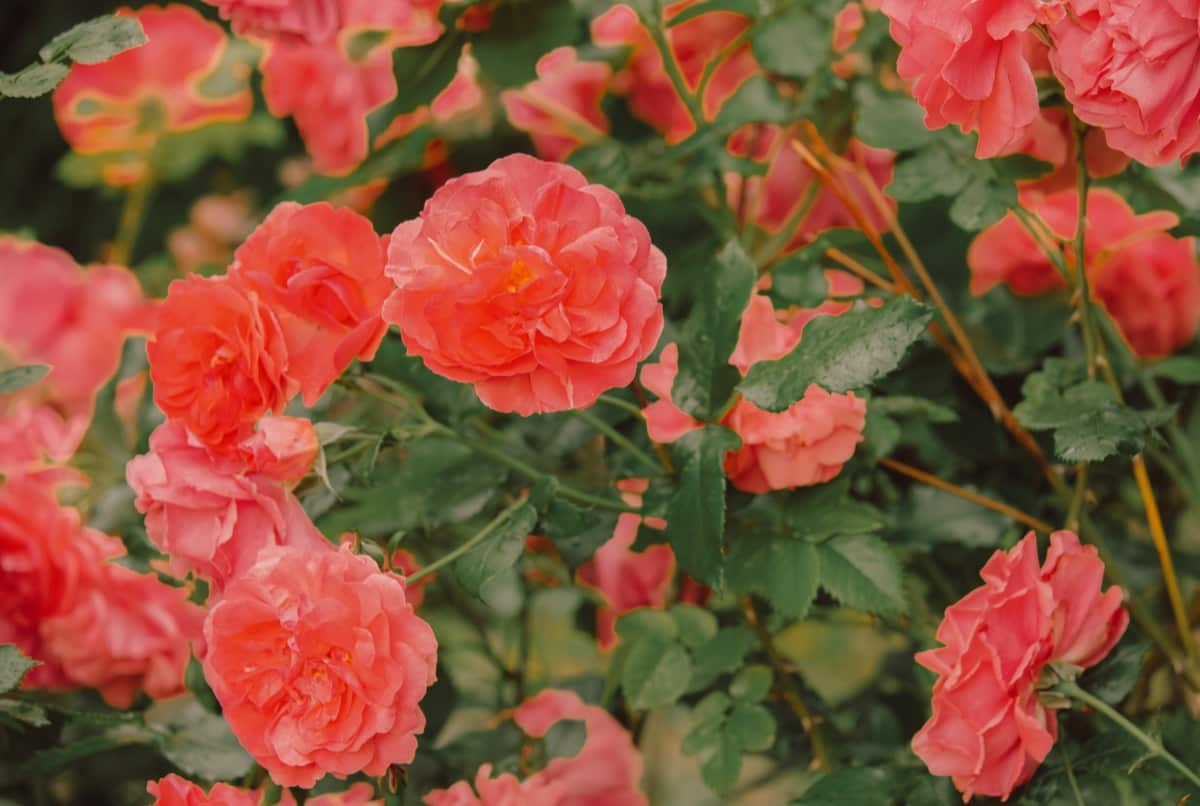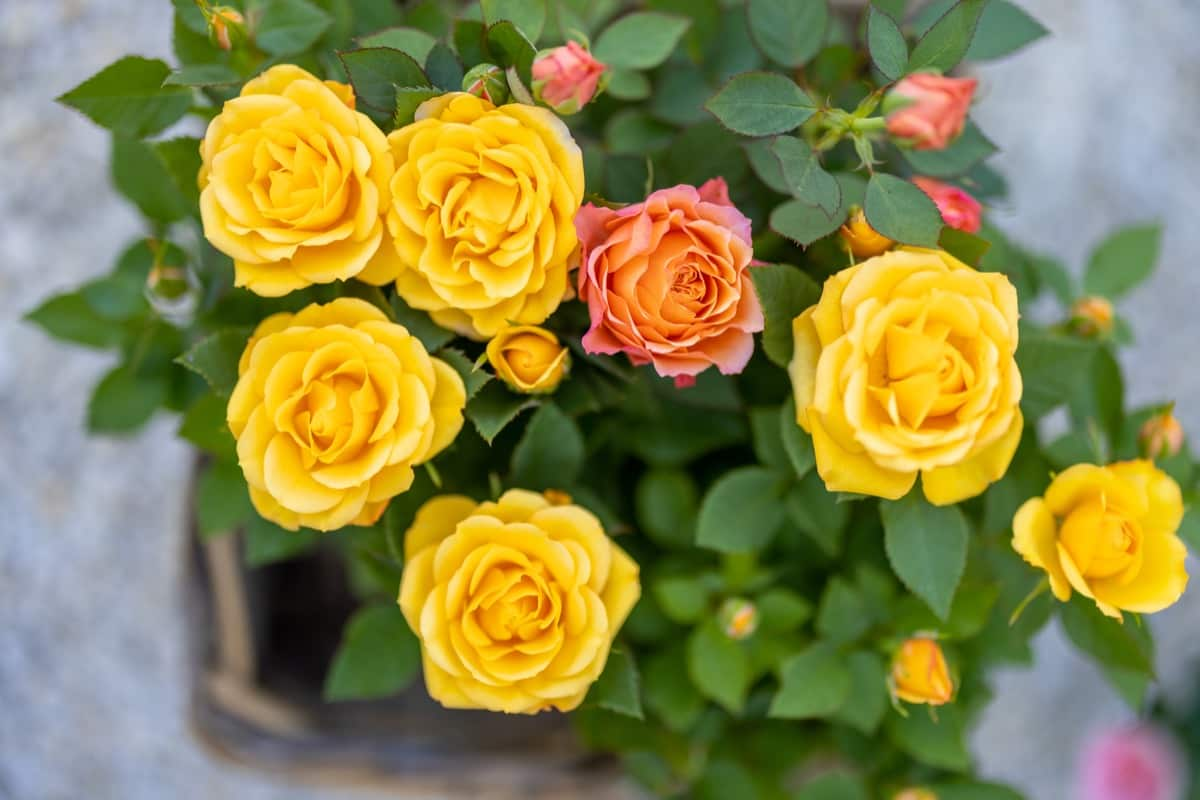Seeing new buds and blooms drop from your rose bush when you’ve been anticipating beautiful spring flowers can be a major disappointment. This can happen for various reasons, but there are some clues you can use to narrow down the cause. To solve the problem, you need to identify the root cause. Pests, diseases, weather fluctuations, lack of nutrients, or a recent move could be to blame for your rose’s ill health. By identifying the problem, you can take steps to restore blooms! We will explain the most common causes of bloom and bud drop (Bud Blast) and how to restore your rose to health.

8 Reasons Why Your Roses Drop Their Flowers
Environmental Factors Leading to Dropped Rose Flowers
Temperature Fluctuations: Rose petals can drop when the weather changes rapidly from cool and damp to hot and dry. Uneven weather patterns may partially open blossoms, causing them to wilt or cause them to fall off. You can lessen the impact of fluctuating temperatures by mulching rose bushes and applying potash-rich fertilizer or phosphate rock and green sand.
Lack of Moisture: Roses require consistent moisture to thrive. If the soil is too dry, the plant may become stressed and drop its flowers. On the other hand, if the soil is too wet, the roots may become waterlogged, which can also cause the flowers to drop.
Improper Nutrition: Roses require a balanced diet of nutrients to produce healthy blooms. If the plant is not receiving the proper nutrients, it may drop flowers. Additionally, if the plant receives too much fertilizer, it may become over-stimulated, leading to dropped flowers.
Pest Infestations: Pests such as aphids and spider mites can cause significant damage to rose plants. If the plant is infested with pests, it may drop flowers as a defense mechanism.
Sunlight Exposure: While roses require significant sunlight to grow, too much sunlight can also cause dropped flowers. If the rose plant is exposed to direct sunlight for an extended period, the flowers may become dehydrated and drop.
Improper Watering and Its Impact on Rose Flower Retention
Overwatering is a common problem that can lead to poor flower retention. When roses are overwatered, the soil becomes waterlogged, and the roots cannot get enough oxygen. This leads to root rot, which can cause the plant to wilt and eventually die. Overwatering also leads the leaves to turn yellow and fall off, leading to poor flower retention. Underwatering is also a common mistake that can affect the retention of rose flowers.
When plants are not watered enough, they can become stressed, leading to wilting and dropping of flowers. In extreme cases, the plant can even die from dehydration. Watering the plants deeply once or twice a week is recommended, depending on the climate and weather conditions. This allows the roots to absorb the water they need to sustain the plant without causing them to become waterlogged.
Rose Diseases Causing Flower Drop: Identifying the Culprits
Brown speckles or larger blotches can appear on blooms caused by botrytis blight. Occasionally, some buds may fail to develop properly, wither, and fall off. The most likely time for Botrytis cinerea to appear is during mild temperatures and rainy conditions in the spring or fall. Rose rosette disease is a disease caused by a virus that is spread by mites. It causes the plant to develop a witches’ broom, a cluster of small, twisted branches. The flowers on the affected branches will drop off prematurely.
There are several ways to prevent the occurrence of these diseases in rose plants. First, it is important to choose disease-resistant varieties of roses when planting. Good sanitation practices, such as removing fallen leaves and debris around the plants, can also help prevent the spread of diseases. Regular pruning and fertilization can also help keep the plants healthy and less susceptible to infections.
Insect Pests and Their Effect on Rose Bloom Longevity
Rose Weevil: The rose weevil is a small beetle that attacks pale-colored roses, especially yellow and white roses. When the rose weevil plagues roses, their stems break under the buds, resulting in dropped blooms. There may be holes in the petals of roses that remain. Once hatched, the larvae chew petals and cause damage once they have punctured buds and laid their eggs.
In case you missed it: 10 Reasons Why Your Roses Aren’t Blooming: Treatment and Solutions

Treatment: If they appear in extreme numbers, an insecticidal soap may be helpful
Thrips: Through sap extraction from leaves and flowers, thrips weaken roses. Roses with light colors are most commonly attacked by them.
Treatment: Introducing natural predators such as pirate bugs and lacewings to your garden will reduce the likelihood of future outbreaks. Adding a variety of plants to the garden will also make your garden attractive to them in the long run.
Nutrient Efficiencies and Dropped Flowers in Rose Plants
- Nitrogen: A nitrogen deficiency can cause leaves to turn yellow; the plant may produce fewer flowers or drop them prematurely.
- Treatment: As slow-release nitrogen fertilizers, such as blood meal or bone meal, release nitrogen gradually over a longer period.
- Phosphorus: A deficiency in this nutrient can result in stunted growth and weak plants. It also causes leaves to turn dark green or purple, and flowers may fail to open properly before dropping.
- Treatment: Organic fertilizers such as bone meal, rock phosphate, and guano are rich in phosphorus and can be used to remedy this deficiency.
- Potassium: A potassium deficiency can cause leaves to wilt and yellow, and flower buds may drop before they have a chance to bloom.
- Treatment: Organic fertilizers such as kelp meal, greensand, and wood ash are rich in potassium and can be used to remedy this deficiency.
- Other nutrient deficiencies, such as calcium, magnesium, and iron, can also impact the health of rose plants and cause issues such as yellowing leaves and flower drops.
Stressors and Their Influence on Rose Flower Retention
Abiotic stressors such as high temperatures can cause rose flowers to wilt and fall off prematurely. Water stress from too little or too much watering can also affect flower retention. Nutrient deficiencies, particularly phosphorus, and potassium, can lead to poor flower development and eventual drop. Environmental factors like air pollution and soil salinity can also affect rose flower retention. High levels of air pollutants such as ozone and sulfur dioxide can cause damage to the leaves and flowers of roses, reducing flower retention.
High soil salinity levels can also cause water stress and nutrient deficiencies, leading to poor flower development and eventual drop. Gardeners and florists should be aware of these stressors and take steps to mitigate their impact as much as possible. Proper care and maintenance, like regular watering and fertilization, can help mitigate the effects of stressors on rose flower retention.
Overcrowding and Competition Leading to Dropped Rose Blooms
Overcrowding and competition can be detrimental to rose blooms. When planted too closely, rose bushes must compete for water, nutrients, and sunlight. As a result, the blooms may drop prematurely or not develop fully. Give rose bushes enough space to grow and thrive. When planting roses, be sure to space them out according to their specific needs. Hybrid tea roses, for example, should be planted about 18 inches apart, while climbing roses may need up to 10 feet of space.
In case you missed it:
Treatment: A bad-infested bush’s buds should be snipped and thrown away. Adults can be killed by shaking them into soapy water.
Aphids: An aphid infestation can be identified by the presence of colonies of visible bugs around a tender new rosebud. Aphids are usually the first pests to appear in early spring, sucking sugary juices from roses with piercing mouthparts. Their damage might also be evident in distorted buds and curled leaves.
In case you missed it: How to Grow and Care for Rose Plants: Propagation and Planting Instructions for Best Blooms

Pruning Mistakes and Their Role in Rose Flower Drop
- One of the most common pruning mistakes is to cut too much of the plant at once. It can lead to shock the plant and cause it to drop its flowers. To avoid this, it is important to prune the plant gradually, not removing more than one-third of the plant at a time.
- Another mistake gardeners make when pruning roses is cutting the stems too short. This can result in weak new growth and a lack of flowers. It is important to leave at least two to three buds on each stem when pruning to avoid this.
- Over-pruning is another mistake that can lead to flower drops. Some gardeners believe that pruning heavily will result in bigger and better blooms. However, this is not always the case. Over-pruning can weaken the plant and cause it to drop its flowers.
Conclusion
In conclusion, roses drop their flowers for various reasons, including environmental factors, disease and pest infestation, and cultural practices. Understanding the causes of flower drops and adopting preventative measures such as proper watering, fertilization, pruning, and disease and pest control can help keep roses healthy and blooming.
- Feed Your Flock for Less: Top 10 Tips to Save on Chicken Feed
- Ultimate Guide to Ossabaw Island Hog: Breeding, Raising, Diet, and Care
- Hatching Answers: The Top 10 Reasons Your Chickens Aren’t Laying Eggs
- Eggs and Economics: Breaking Down the Cost of Raising Backyard Chickens
- Defend Your Greens: Proven Methods to Keep Iguanas Out of Your Garden
- Ultimate Guide to Cinnamon Queen Chicken: A Comprehensive Guide for Beginners
- Ultimate Guide to California Tan Chicken: Breeding, Raising, Diet, Egg-Production and Care
- Ultimate Guide to Marsh Daisy Chicken: Breeding, Raising, Diet, and Care
- 10 Types of Chicken Farming Businesses You Can Start for Profits